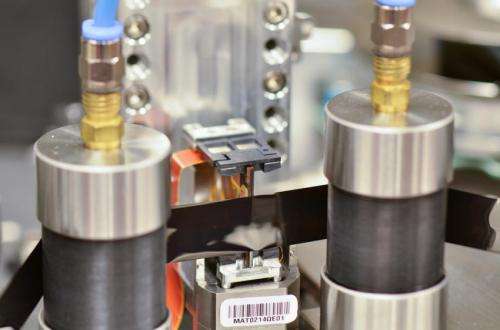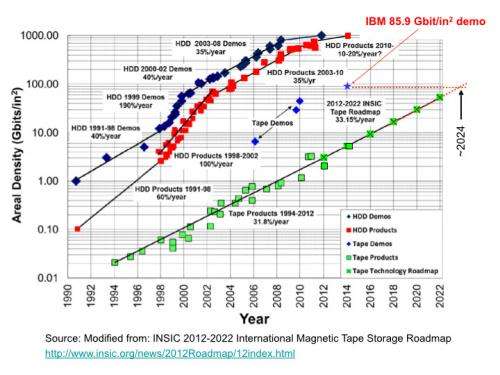85.9 billion bits per square inch: IBM research sets new record for storing massive amounts of big data

Today, IBM researchers announced they have demonstrated a new record of 85.9 billion bits of data per square inch in areal data density on low-cost linear magnetic particulate tape—a significant update to one of the computer industry's most resilient, reliable and affordable data storage technologies for Big Data.
At this areal density, a standard LTO size cartridge could store up to 154 trillion bytes (154 terabytes) of uncompressed data—a 62 fold improvement over an LTO6 cartridge, the latest industry-standard magnetic tape product. To put this into perspective, 154 terabytes of data is sufficient to store the text from 154 million books, which would fill a book shelf stretching from Las Vegas to Seattle, Washington.
This new record was achieved using a new advanced prototype tape, developed by FUJIFILM Corporation of Japan. This is the third time in less than 10 years that IBM scientists in collaboration with FUJIFILM have achieved such an accomplishment. The news is being unveiled this week at the IBM Edge conference in front of more than 5,500 attendees.
IBM scientists break Big Data into four dimensions: volume, variety, velocity and veracity and by 2020 these so-called Four V's of Big Data will be responsible for 40 zettabytes (40 trillion gigabytes) of data. Much of this data is archival, such as video archives, back-up files, replicas for disaster recovery, and retention of information required for regulatory compliance. Because tape systems are energy efficient and more cost-effective than hard disks they are the ideal technology to store, protect and access archival Big Data.
For example, the Large Hadron Collider (LHC) is the world's largest and most powerful particle accelerator. By the end of the LHC first three-year running period, more than 100 petabytes of physics data had been stored in the CERN mass-storage systems. Most of this data is archived on more than 52,000 tape cartridges of different types, providing scientists with permanent access to data, which could someday answer fundamental questions about the universe.
"Big data has met its match with tape, not only does the technology provide high capacity in a small form factor, it is also reliable for several decades, requires zero power when not in use, is secure in that cartridges cannot be erased at the push of the keystroke and available for the cloud —all at a cost of less than 2 cents per gigabyte and at a greatly reduced operating expense versus disk storage," said Evangelos Eleftheriou, IBM Fellow.
To achieve 85.9 billion bits per square inch, IBM researchers have developed several new critical technologies, including:
- a new enhanced write field head technology that enables the use of much finer barium ferrite (BaFe) particles
- advanced servo control technologies that achieve head positioning with nano-scale fidelity and enable a 27 fold increase in track density compared to the LTO6 format
- innovative signal-processing algorithms for the data channel that enable reliable operation with a ultra narrow 90nm wide giant magnetoresistive (GMR) reader.
Since 2002, IBM has been working closely with FUJIFILM particularly on the optimization of its dual-coat magnetic tape based on BaFe particles. In this time IBM scientists in Zurich have dramatically improved the precision of controlling the position of the read-write heads, leading to a dramatic increase in the number of tracks that can be squeezed onto the half-inch-wide tape. In addition, they have developed new advanced detection methods to improve the accuracy of reading the tiny magnetic bits, thereby achieving an increase in the linear recording density of more than 56 percent while enabling the use of a reader that is only 90nm in width.

IBM scientists envision scaling magnetic tape to even higher areal densities in the future and will continue to explore novel media technologies. Earlier this month at the 2014 Intermag conference IBM scientists in Almaden, California, have shown that there is potential to continue scaling tape areal densities beyond 85.9 billion bits per square inch. The scientists studied the magnetic properties of a small sample of sputtered media using two specialized test apparatuses. This is an important breakthrough under highly controlled laboratory conditions that may point the way to continue scaling magnetic recording by means of sputtered media once the potential of low-cost particulate media has been exhausted, but much more research will be required.
IBM has a long history of innovation in magnetic-tape data storage. Its first commercial tape product, the 726 Magnetic Tape Unit, was announced more than 60 years ago. It used reels of half-inch-wide tape that each had a capacity of about 2 megabytes. The areal density demonstration announced today represents a potential increase in capacity of 77,000,000 times compared with IBM's first tape drive product.
Technical details for Tape Record
IBM's world-record achievement leverages breakthrough improvements in 4 areas of the magnetic tape system:
1. New high-density particulate NANOCUBIC BaFe magnetic tape: The enhanced NANOCUBIC technology decreases BaFe magnetic particle volume, which is essential for high-density data recording, while maintaining its thermal stability to ensure long term archivability of recorded data. Developed by FUJIFILM Corporation in Japan in close collaboration with IBM Research scientists, this enhanced next-generation NANOCUBIC tape incorporating NANO coating and dispersion technology and ultra fine, perpendicularly-oriented BaFe particles enables high-density data recording without using expensive metal sputtering or evaporation coating methods.
2. Enhanced write field head technology: In collaboration with colleagues in the IBM San Jose Tape Head Development group, the IBM Research - Zurich team developed a new write head technology that produces significantly stronger magnetic fields. This new head technology enables the use of smaller volume magnetic particles with increased coercivity that ensures the long term archival stability of data stored on a tape.
3. Advanced servo control technologies for head positioning with nano-scale fidelity: to enable aggressive track density scaling, the IBM team made several advances in the area of track follow performance leading to a more than 27-fold increase in the number of data tracks compared to the LTO6 format: 1) a new prototype low noise tape transport system; 2) an experimental servo pattern which in combination with 3) an improved method for detecting the position information encoded in the servo pattern enables the generation of position measurements with nano-scale resolution, and 4) an advanced H-infinity based track follow controller. Combining all of these technologies, the team demonstrated a track-follow performance with a standard deviation of only 10.3 nanometers from the target track position. These technologies in combination with a 90nm wide GMR read head enable the use of a track width of 177nm.
4. Innovative signal-processing algorithms for the data channel: A new data channel that combines an advanced timing recovery scheme with a data-dependent noise-predictive, maximum-likelihood (DD-NPML) detection scheme and a new iterative decoding scheme which together enable the reliable retrieval of data recorded on the new BaFe media at a linear density of 600,000 bits per inch with a 90nm wide GMR read head. This combination of technologies ensures the same user bit error rate performance as is achieved with the latest IBM enterprise tape drive despite the dramatic reduction in reader width and increase in linear density.
Provided by IBM

















